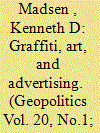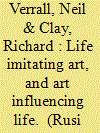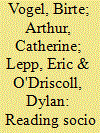|
|
|
Sort Order |
|
|
|
Items / Page
|
|
|
|
|
|
|
| Srl | Item |
| 1 |
ID:
138971


|
|
|
|
|
| Summary/Abstract |
Physical barriers are an increasingly popular political mechanism for central government control over the flows of goods and people at borders. This medium also, however, serves as a canvas for unsanctioned expressions of belonging. Just as graffiti and art are deployed in the urban landscape as unconventional means of claiming space, they are utilised on international border barriers to contest prevalent political winds and re-claim local and alternative senses of who belongs and what is deemed important in debates over border policy. This paper considers unauthorised text and visual imagery on the border barriers of the Arizona-Sonora section of the US-Mexico boundary as a therapeutic reaction to a state-dominated border policy which downplays local impacts. It is argued that such imagery serves to re-scale border space and thereby re-capture a sense of belonging by those whose roles are marginalised by national politics and the neoliberal global economy.
|
|
|
|
|
|
|
|
|
|
|
|
|
|
|
|
| 2 |
ID:
146323


|
|
|
|
|
| Summary/Abstract |
Graffiti has had a chequered past in the art world and in society in general, and its use in warfare has also been underplayed. In this thought-provoking article, Neil Verrall and Richard Clay illuminate the historical role and impact of graffiti in society, art and war; they argue for a fresh look at its contemporary use within influence operations and behaviour change in a time of ‘warfare in the information age’.
|
|
|
|
|
|
|
|
|
|
|
|
|
|
|
|
| 3 |
ID:
175531


|
|
|
|
|
| Summary/Abstract |
This paper argues that graffiti can provide a form of socio-political commentary at the local level, and is a valuable, yet often overlooked, resource for scholars and policymakers in conflict-affected societies. Graffiti, in its many forms, can provide rich insight into societies, cultures, social issues, trends, political discourse, and spatial and territorial identities and claims. Thus, this, paper suggests that graffiti is a valuable source of knowledge in societies undergoing social and political transformation, to hear the voices of those often left out from the official discourses. Despite advances in the field of arts and international relations and the focus on the local and the everyday, peace and conflict scholarship and policy still lack systematic engagement with arts-based contributions and how to read them. The paper attempts to address this gap by outlining four core dimensions to consider when attempting to interpret and decode graffiti: the spatial, temporal, political economic and representative dimensions. This can also be viewed as an inquiry into the where, when, who and what. These four elements make up an analytical guide and enable scholars to better understand graffiti, and its political meaning and messaging.
|
|
|
|
|
|
|
|
|
|
|
|
|
|
|
|
|
|
|
|
|